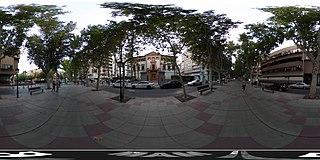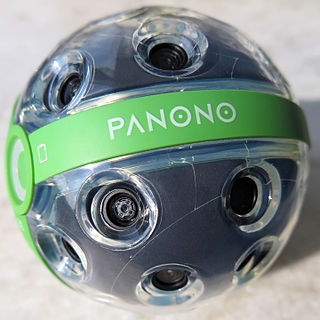
A panorama is any wide-angle view or representation of a physical space, whether in painting, drawing, photography, film, seismic images, or 3D modeling. The word was coined in the 18th century by the English painter Robert Barker to describe his panoramic paintings of Edinburgh and London. The motion-picture term panning is derived from panorama.

In photography, angle of view (AOV) describes the angular extent of a given scene that is imaged by a camera. It is used interchangeably with the more general term field of view.

In photography and cinematography, a wide-angle lens is a lens covering a large angle of view. Conversely, its focal length is substantially smaller than that of a normal lens for a given film plane. This type of lens allows more of the scene to be included in the photograph, which is useful in architectural, interior, and landscape photography where the photographer may not be able to move farther from the scene to photograph it.
Panoramic photography is a technique of photography, using specialized equipment or software, that captures images with horizontally elongated fields of view. It is sometimes known as wide format photography. The term has also been applied to a photograph that is cropped to a relatively wide aspect ratio, like the familiar letterbox format in wide-screen video.
IPIX was an imaging technology company headquartered in Cohoes, New York. It supplies hardware and software for producing, publishing, embellishing, and collaborating with spherical imagery.
QuickTime VR is an image file format developed by Apple Inc. for QuickTime, and discontinued along with QuickTime 7. It allows the creation and viewing of VR photography, photographically captured panoramas, and the viewing of objects photographed from multiple angles. It functions as plugins for the QuickTime Player and for the QuickTime Web browser plugin.

Hugin is a cross-platform open source panorama photo stitching and HDR merging program developed by Pablo d'Angelo and others. It is a GUI front-end for Helmut Dersch's Panorama Tools and Andrew Mihal's Enblend and Enfuse. Stitching is accomplished by using several overlapping photos taken from the same location, and using control points to align and transform the photos so that they can be blended together to form a larger image. Hugin allows for the easy creation of control points between two images, optimization of the image transforms along with a preview window so the user can see whether the panorama is acceptable. Once the preview is correct, the panorama can be fully stitched, transformed and saved in a standard image format.
A virtual tour is a simulation of an existing location, usually composed of a sequence of videos, still images or 360-degree images. It may also use other multimedia elements such as sound effects, music, narration, text and floor map.

Image stitching or photo stitching is the process of combining multiple photographic images with overlapping fields of view to produce a segmented panorama or high-resolution image. Commonly performed through the use of computer software, most approaches to image stitching require nearly exact overlaps between images and identical exposures to produce seamless results, although some stitching algorithms actually benefit from differently exposed images by doing high-dynamic-range imaging in regions of overlap. Some digital cameras can stitch their photos internally.

360-degree videos, also known as surround video, or immersive videos or spherical videos, are video recordings where a view in every direction is recorded at the same time, shot using an omnidirectional camera or a collection of cameras. The term 360x180 can be used to indicate 360° of azimuth and 180° from nadir to zenith. During playback on normal flat display the viewer has control of the viewing direction like a panorama. It can also be played on a display or projectors arranged in a sphere or some part of a sphere.

VR photography is the interactive viewing of panoramic photographs, generally encompassing a 360-degree circle or a spherical view. The results is known as VR photograph, 360-degree photo, photo sphere, or spherical photo, as well as interactive panorama or immersive panorama.

A panoramic tripod head is a piece of photographic equipment, mounted to a tripod, which allows photographers to shoot a sequence of images around the entrance pupil of a lens that can be used to produce a panorama. The primary function of the panoramic head is to precisely set the point of rotation about the entrance pupil for a given lens and focal length, eliminating parallax error.

In robotics and computer vision, visual odometry is the process of determining the position and orientation of a robot by analyzing the associated camera images. It has been used in a wide variety of robotic applications, such as on the Mars Exploration Rovers.

The Brenizer method, sometimes referred to as bokeh panorama or bokehrama, is a photographic technique characterized by the creation of a digital image exhibiting a shallow depth of field in tandem with a wide angle of view. Created by use of panoramic stitching techniques applied to portraiture, it was popularized by photographer Ryan Brenizer.
A 3D rig is a device for mounting two cameras together to one 3D-system in order to shoot stereoscopic films and images.

Panoweaver is an image stitching app. It supports telephoto, normal, wide angle and fisheye lens images into full 360*180 spherical panoramic image. Panoweaver also supports exporting 360 panoramic images into Flash VR, QuickTime VR, Java-based VR tours and swf, and publish on Facebook.

Panono is a spherical camera developed by the Berlin-based company Professional360 GmbH, formerly known as Panono GmbH. The camera captures full-spherical, 360° x 360° panoramic images with a resolution of 108 megapixels.
Arashi Vision Inc., doing business as Insta360, is a camera company headquartered in Shenzhen, China with offices in Los Angeles, Tokyo and Berlin. It makes action cameras, 360-degree cameras, editing software for mobile and desktop computers, and stereoscopic 180-degree cameras.















